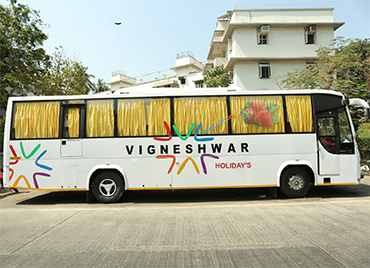Welcome to Ashtavinayak Tour
We specialize in Ashtavinayak Tour/Yatra (pilgrimage).
Ashtavinayaka means “eight Ganeshas” in Sanskrit. Ganesh is the deity of unity, prosperity & learning which removes obstacles. Visiting the temples of Ashtavinayaka refers to a pilgrimage to the eight Ganesh temples in Maharashtra state of India that house eight distinct idols of Ganesha, in a pre-ascertained sequence. This trip covers the eight ancient holy temples of Ganesha which are situated around Pune. Each of these temples has its own individual legend and history, as distinct from each other as the murtis in each temple.
Destinations Covered :
Varadavinayak (Mahad), Ballaleshwar (Pali), Mahaganapati (Rajangaon), Chintamani (Theur), Siddhivinayak (Siddhtek), Mayureshwar (Morgaon), Vigneshwar (Ozzar), Girijatmaj (Lenyadri).
Bus Packages
Pick a bus package that best suits your taste and budget
Deluxe Bus Package for Ashtavinayak Tour/Yatra
————————————————————————–
3 Days / 2 Nights | Cost: Rs. 6000 per person
————————————————————————–
Starts every Friday from Mumbai. Ashtavinayak tour 2×2 AC Coach. Stay in Deluxe Hotel. All Meals Included.
Super Deluxe Bus Package for Ashtavinayak Tour/Yatra
————————————————————————–
3 Days / 2 Nights | Cost: Rs. 6500 per person
————————————————————————–
Starts every Friday from Mumbai. Ashtavinayak tour 2×2 AC Coach. Stay in Deluxe Hotel. All Meals Included.
Standard Bus Package for Ashtavinayak Tour/Yatra
————————————————————————–
3 Days / 2 Nights | Cost: Rs. 6000/- per person
————————————————————————–
Only bulk group booking requirement. Non AC Bus and Non AC Room.
Car Packages
Pick a car package that best suits your taste and budget
Super Deluxe Car Package for Ashtavinayak Tour/Yatra
————————————————————————–
2 Days / 1 Nights | Cost: Rs. 23000/- per couple
————————————————————————–
Customize Car Package from Mumbai. Travel by Sedan AC Car. Stay in Deluxe Hotel. Breakfast & Dinner Included.
Super Deluxe Car Package for Ashtavinayak Tour/Yatra
————————————————————————–
3 Days / 2 Nights | Cost: Rs. 28000/- per couple
————————————————————————–
Customize Car Package from Mumbai. Travel by Innova AC Car. Stay in Deluxe Hotel. Breakfast and Dinner included.
Tempo Traveller Package for Ashtavinayak Tour/Yatra
————————————————————————–
3 Days / 2 Nights | Cost Rs. 6500/- per person
————————————————————————–
Customize Tempo Traveller Package from Mumbai. Travel by AC/Non AC. Stay in Deluxe Hotel. Breakfast and Dinner included.






















